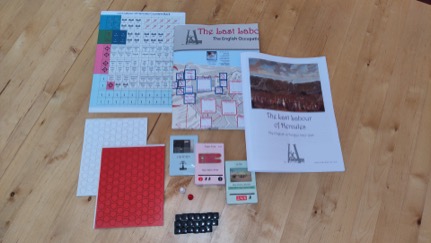The Game
The Last Labour of Hercules is a game about the English occupation of Tangier during the second half of the 17th Century. The port was bequeathed to King Charles II as part of a dowry when he married the Portuguese princess, Catherine of Braganza. It would be another generation before the English captured Gibraltar from Spain, but Tangier seemed an ideal base for many of the same reasons. It would be a handy staging post for ships bound for West Africa and the Caribbean, it would place a watch upon the Catholic Spanish, and it might facilitate trade with the Moors, the port being one terminus of the ancient caravan route for slaves and gold-dust. There were only two problems. First, the Moors hated outsiders. Second, but more importantly, the port lay open to the worst the Atlantic could throw at it. The anchorage was deep, but it was unprotected. For twenty-two years the English tried to maintain themselves at Tangier, and withstood at least two significant sieges by the Moors, but at last the Government decided they had wasted enough money, though the fact that the Moors had at last forged a unified (and powerful) kingdom might have had something to do with the decision to pull out.
The Last Labour of Hercules is part card game and part wargame. Covering a period of twenty years, it does not represent a single siege of Tangier but many attempts, some large and some small, by the Moors, to dislodge the English. For long periods the protagonists tolerated each other, and the English even formed the odd local alliance. The Moors spent much of the period of occupation engaged in a brutal civil war — or put another way, they were in the process of emerging from Medieval anarchy. Also, they had to ward off attempts by the Ottoman Sultan to reestablish his suzerainty over the land.
So, the wargame portion of the game covers the fighting and the card game covers both times of peace and preparations for war. Card play is simply a back-and-forth, with each player on his turn playing and drawing a card; the cards can be used for various things, such as troop buildup, resource expenditure, or events. At various points in the game the Moorish player will decide he is sufficiently prepared for an assault on Tangier. Card play stops and the players set up their forces (represented by wooden cubes) on the game map. The map uses a point-to-point grid for movement and combat. Combat turns are I-go-U-go with movement following all individual attack resolutions. One key feature of the combat system is the expenditure of cubes (troops) to maintain momentum — so long as you are prepared to burn troops you can continue attacking in a given sector until you break through, but at the cost of holding onto future gains. Unless the Moorish player is both skilled and lucky (or the English player is more than historically inept), the Citadel will probably hold, so once he has decided he can score no more gains the Moor will call off the attack. At this point the board is scored, with the points being used to aid in the fulfilment of the Moorish player's political goals, and the pieces are removed from the board.
As the English player you must keep the Moors at bay while gauging how many of your precious resources you can spare to build Tangier’s Great Mole – a breakwater that will protect your ships.
As the Moorish player you must endevour to make the English inclined to leave, ideally by sacking Tangier. At the same time, you have two additional problems to deal with. First, there is the small matter of a civil war among the Berber tribes. Then, there is the Sultan at Istanbul. He seems to be under the false impression that Morocco belongs to him.
If the Moors ever take the town's Citadel they win outright. If the English ever complete the Great Mole they win outright. If neither side can achieve their main objective, someone might or might not win on points, by comparing the English player’s progress on the Mole against the Moorish player’s ability to secure Morocco for his dynasty.
Playing time averages 3 hours. Card play is very quick but players usually launch between 2-4 attacks against Tangier during the game and these can take some time to resolve. Experience will speed play.
Components
1) Rulebook
2) 22”x34” paper map prepresenting the town and fortifications of Tangier
3) Three card decks: 1x 60 card Action Deck for each player and a 9-card Cistern Deck
4) One counter sheet of 120 counters (various tokens and markers)
5) 100x white wooden cubes (Moorish Troops)
6) 100x red wooden cubes (English Troops)
7) 20x large black wooden cubes (Artillery)
8) One white pawn (Moorish Leader)
9) One red pawn (English Leader)
Print & Play Requirements
If you buy the Print & Play version there are two extra hoops you have to jump through:
1) LLH comes with special decks of CARDS. These are available at DriveThru Cards™. You have the option of ordering the physical decks from them at a combined cost of $16.00 USD plus shipping (there are 3 decks in all), or downloading free PDFs. Go to DriveThru Cards and search for Red Sash Games or Last Labour of Hercules. Be sure to order all THREE decks.
The other thing you will need are sets of wooden (or plastic) CUBES. You will need 100 White cubes, 100 Red cubes, and 20 Black cubes; the black cubes should be larger than the others. Also, you will need 1 Red and 1 White pawn, or similar markers. 100-piece bags of cubes can be found at a number of online game supply stores. The average North American price appears to be $8.00 per bag.
